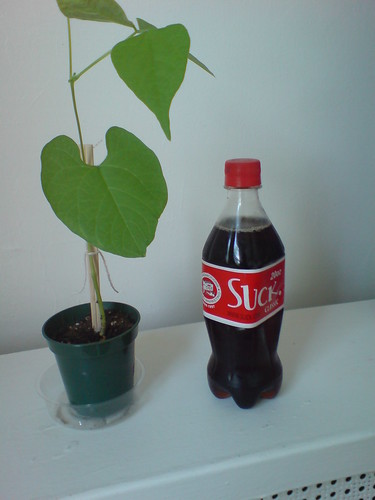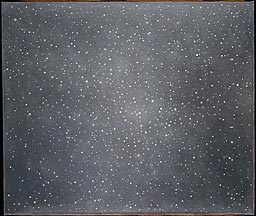
A guard at the Carnegie International defaced a Vija Celmins painting, Night Sky #2, making a “long vertical gouge” with a key. The conservator calls it a “total loss,” though the Art Institute of Chicago, which owns the 1991 painting, said they would look at the possibility of repairing it.
Though the story only surfaced on Friday in the Pittsburgh Post-Gazette, the incident occurred on May 16th [a Friday]. The guard, an Azerbaijani immigrant named Timur Serebrykov, was confronted about the action and arrested on May 20th [a Tuesday]. He initially denied any wrongdoing, but then he confessed, adding, “I didn’t like the painting.” There were eight Celmins paintings of night skies in the gallery at the time.
Guard charged with ruining museum piece [post-gazette.com via artforum]
Night Sky #2, 1991, Vija Celmins [artic.edu]
Enzo Mari x Ikea Mashup, Ch. 2: Parts
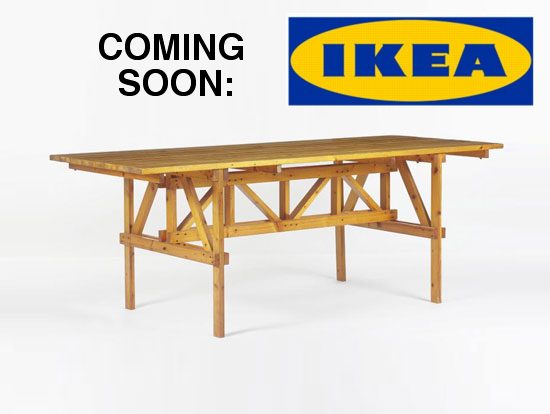
In the early 1970’s, Enzo Mari suggested using 1-by pine lumber to make his autoprogettazione furniture because it was cheap, standardized, easy to cut, and universally available at the corner hardware store. Now, my local hardware is a Home Depot, and the boards they sell come from New Zealand. So in keeping with the spirit of Mari’s design, I’m going to use components from Ikea furniture kits instead.
The dining table I’m going to make is called either F or EFFE, depending on which plans you look at [Mari’s own autoprogettazione book uses the former; Peter Stamberg’s 1976 blueprint anthology, Instant Furniture, which reproduces four of Mari’s autoprogettazione designs, uses the latter.] It calls for wood in two sizes. The truss and leg structure is made of 1×2 in lengths ranging from 10 1/2″ to 51″. The top calls for four 79-inch 1×8 planks, which actually comes to about 30″ across. [After it’s dried and finished, 1×8 boards are usually 3/4″ x 7 1/2″. I had no idea.]
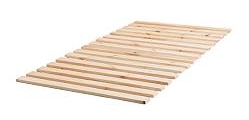
There turns out to be far fewer useful sources of lumber in Ikea than I originally thought. [The idea hit me when I passed giant warehouse shelves filled with rolled up pine bed slats.] But most of the pine pieces in Ikea furniture are only 1/2-inch thick, too thin to use for underpinning a table.
Though I stuck to pine on principle, there is some solid wood furniture, mostly birch, with some oak. But by far, most of the wood-looking furniture is made from veneered particleboard; who knows what’d happen if you cut it?
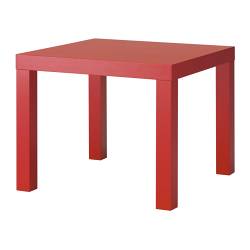
I don’t doubt you could make a quintessentially Ikea Mari table by using only these kinds of components; the sleek, plastic-over-sawdust goodness of Ikea’s signature Lack tables and shelves could make for a very conceptually tight mashup, but that’d be the second or third piece I’d make, not the first.
The other major constraint is the length of the boards for the top; only three products have decent width pine boards within range of 79 inches [which is 200cm, if you’re wondering why Mari picked that length]. The 5/8-in. thick sides of the tallest Trofast storage units [above] are either 11 3/4 in. or 17 in. deep, but only 69 in. tall. And some of them have regularly spaced grooves for sliding bins.
[Though it felt like cheating, I did check out readymade tabletops. The Vika Furuskog tabletop comes in pine, and is 78 3/4 in. long, but only 23 5/8 in. wide; too narrow to use, too wide to double up on.]
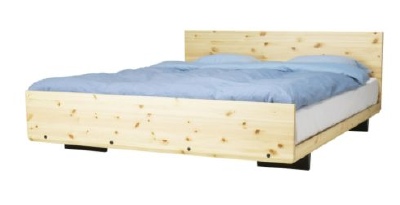
The new Mandal bed [king-size, $249] comes really close to being the perfect Mari table kit. It has a smoothly sealed headboard and footboard of solid pine, which, on the king size model, are each 78 in. long. The headboard is 23 1/2″ wide, and the footboard is 12″; placed top-to-top, they’d be 35 1/2″ wide, which isn’t too far off. As a bonus, they have both taper on the bottom edge, which would be nice on the underside of the tabletop. [There is a row of pre-drilled holes along the base of each piece, though, which kind of bugs.]
Mari’s table calls for more than 66 linear feet of 1×2 wood underneath. It’s close, but the Mandal’s inner support rails may provide enough wood without buying extra pieces. The siderails are smoothly finished, too, and each 78 in. piece is 3 in. wide on the outside face, tapering to 2 in. wide on the inside face. The unfinished pieces underneath the bed are either 7/8 x 1 3/4 in. [i.e., 1×2], or 1 3/4 square. Four 1 3/4 sq. pieces are 27 1/2 inches long, just 1/4-in. longer than the table leg specs. If more wood is needed, a $20, twin-sized Sultan Lade bed slat offers one of the best options for raw wood. The 15 slats are 2 3/4 x 3/4 x 38, with slightly beveled top corners.
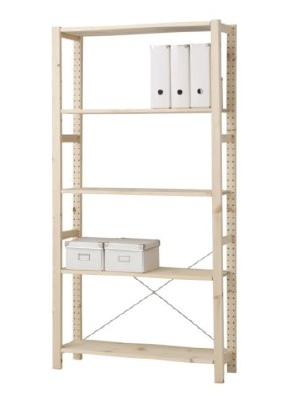
The Mandal has the added benefit of being factory sealed with a smooth acrylic finish. If it’s important to stick close to Mari’s original idea of unfinished wood, the far-and-away winner is the Ivar storage system. Ivar’s component-based, which means the shelves, side units, and corner posts may be all you need to make a table.
One pine top shelf [$19] is 3/4 x 11 3/4 x 82 5/8 inches Cut off the embedded metal brackets from each end, and it’s right at 79 inches. There’s also a vertical piece to cut off [or to not attach in the first place; the shelf I saw didn’t have it at all.] If you use three shelves, the table will be 35 1/4 inches wide, which adds 5+ inches to the horizontal pieces underneath the table, too.
Corner posts are 1 3/4-in. square and filled with drilled holes [$8, $12]. The side units are their own standard dimension–1 3/4 x 1 1/4 inches–which could be pulled apart and used as lumber. But it’s also tempting to use the ladder-like pieces whole. Both parts come in 70 1/4″ and 89″ lengths [$12, $15].
Maybe you could cut down [sic] on the sawing required by just making the table to Ivar’s dimensions instead of Mari’s. Then instead of a lengthwise shelf, you could build a top from shorter 33 x 11 3/4-in. shelves [$6] set crosswise.
I sit here trying to juggle the variables to the best effect: faithfulness to Mari’s original design; faithfulness to his concept, which is not quite the same thing; the inherent “Ikea-ness” of the inputs; the quality and utility of the output; the amount of tweaking, finishing, and labor required. And I repeatedly find myself creating a conceptual justification for the path of least resistance. All conceptual stunts being equal, I’m drawn toward the one that involves the least labor and mess. Which turns out not to be the same as requiring the least time, cost, or effort, as the 8-month over-analysis of making a simple table attests.
This Week in Satelloon-Lookin’ Art News
Macy’s has installed Jeff Koons’ 53-ft tall Bunny balloon in its Chicago store [f/k/a Marshall Fields] in conjunction with the Koons retrospective at the MCA. Katnp has more Bunny photos on flickr.
Yeah, Bubby!
“Sex, for Zohan, is like hummus: there is an endless supply, and no occasion on which it could be judged inappropriate.”
– Anachronistic taste, hedonism, international man of mystery, yet AO Scott’s review makes no mention of Austin Powers at all. Is it a Jewish conspiracy, what?
Face Time
Looks like I picked the wrong week to give up Basel:
Ferreira finally teased the name out of the Englishman, who turned out to be Nicholas Logsdail, founder of Lisson Gallery, at which everyone around me seemed to tense up a bit.
After a brief chat with him, he motioned to step away. Shaking my hand he said, “Pleasure to have met you. I suppose if you’re successful, I’ll see you everywhere, and if you’re not, you’ll disappear.”
— Andrew Berardini
[artforum]
I Think He Said The Secretary Of The Utah Correctional Association Is Near.
Oh my heck, if you read the Washington Post’s article on black folk in Utah, be sure you read it to the end. I love my people and all, but seriously, it is time to wake up:
When [Rodger] Griffin [an African American HR administrator who moved to Utah from Delaware] was voted secretary of the Utah Correctional Association, the 300 people casting ballots did not lay eyes on him until he rose, expecting the applause showered on every other winner asked to stand. What greeted him instead was “exactly” the silence Cleavon Little encounters in “Blazing Saddles,” when his character, the black sheriff, enters a small Western town.
“I’ve had so many weird experiences like that,” said Griffin. “I went to San Francisco, and people didn’t stare at me. And it made me very uncomfortable, because everyone always stares at me.”
The Architecture Market [sic] Bubble Has Popped.
The $19 million deal for Neutra’s Kaufmann House in Palm Springs has been canceled by the sellers for breach of terms.
The Rockefeller Guest House was a New York anomaly. The Farnsworth House was bought by the architecture collector. The. Collector. Andre Balasz’ Prouve is portable. After counting how many houses Michael Govan’s actually added to the LACMA collection, note that the overpriced Louis Kahn house failed to sell. The Breuer trailer-house deal barely made its reserve. Now with the Kaufmann deal unraveling.
I think we can safely say that the modernist architecture market is not, after all, a seamless extension of the art market. Somebody better tell Neutra’s son that he won’t be getting $140 million for the old office building in Silverlake. Or $3.5 million, for that matter.
Official: $19M Kaufmann House sale ‘terminated’ [via archinect]
Peter Young Folded Mandala
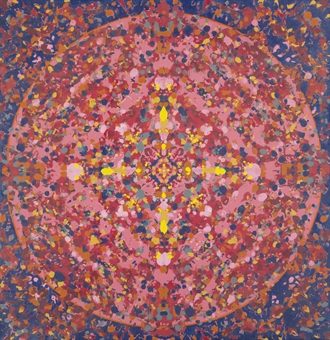
Maybe I shouldn’t post about this until I win the auction, but Peter Young’s Folded Mandala paintings are spectacular, an entrancing mix of hippie, psychedelic beauty and rigorously visible process.
Young left the New York art world behind literally while his show was up at Leo Castelli. The Folded Mandala paintings developed after the schism, so on a purely artistic basis, it was the right thing to do.
Career-wise, however, not so much, but then, that was his point. Young’s paintings from the 1960’s-1980’s were the subject of two tantalizing shows last year, at PS1 and at Mitchell Algus. [Algus had the mandalas].
The shows’ favorable reviews apparently tipped off a sharp-eyed estate sale watcher, who picked up this mandala, #27, just a few weeks ago, and is now flipping it at Christie’s. Rather random estimate: $7-9,000.
Update: seriously, what are the odds? I’d read that Young stopped painting grids after visiting Agnes Martin’s studio in the 1960’s, but check out how Young explained the 1966 encounter to the Brooklyn Rail:
Working at Pace as a preparator, Young had the occasion to visit Agnes Martin’s studio. By this point, he had begun making his own grid paintings, a practice he abandoned shortly after his visit. Martin would twice play a pivotal role in his development. On this occasion Martin herself was not present but her paintings were enough to convince him that he had better reconsider his subject. He turned to images of the night sky and the dotting technique that would shortly bring him notoriety.
I notice that Young’s site has many dot works that pre-date his discovery of Martin’s paintings, but this 1967 dot painting, #8, is wonderful, at once abstract and yet evocative. As if it were a photonegative of a sky survey, perhaps.
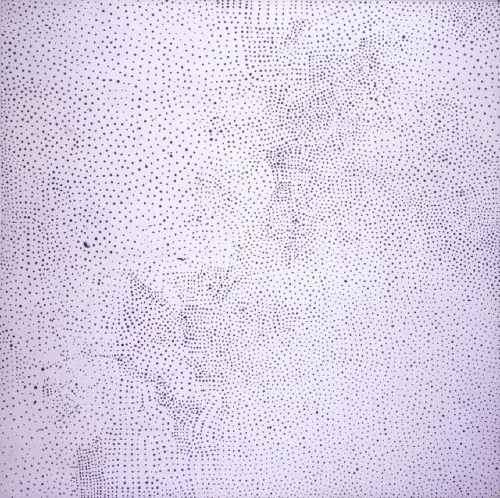
Weird title for a great review: Kandy-Colored Dot-Flake Streamline Maverick [nyt]
also a nice slideshow [nyt]
Chladni Figures
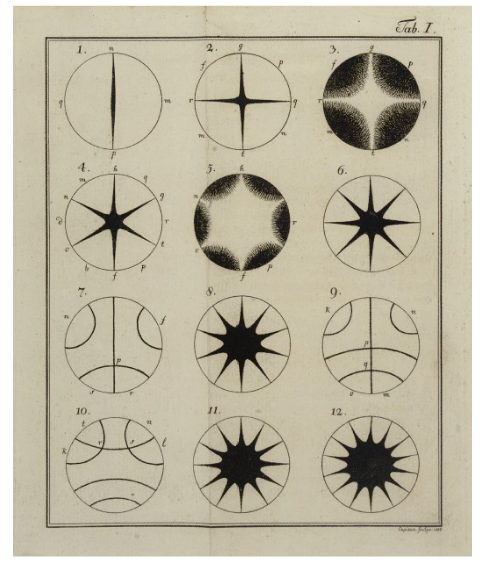
Ernst Florens Friedrich Chladni was the first to devise a way to visualize the sounds transmitted by solid objects using sand. “He demonstrated the method by sprinkling sand on plates of glass or metal and drawing a bow down their sides to produce a visible vibration pattern called ‘Chladni figures.'”
Chladni published engraved images of these figures in a 1787 portfolio, Entdeckungen über die Theorie des Klanges., a first edition of which is to be auctioned at a sale of The Richard Green Library of Scientific Books, June 17 at Christie’s New York.
CHLADNI, Ernst Florens Friedrich (1756-1827), est. $4,000-6,000 [christies]
Previously, somewhat related: Spatial Vibration: an experiment in visualizing sound by members of Olafur Eliasson Studio
After Hours, Frankly
Interesting. The script for one of my favorite Scorsese films, his dark, odd 1985 After Hours, appears to have been heavily lifted from a 1982 performance by Joe Frank, one of my favorite dark, odd radio dramatists. Andrew Hearst has connected the dots, apparently for the first time in print.
Joseph Minion’s script for After Hours began as a screenwriting class project at Columbia. His original title was reportedly Lies, which is the same name as Joe Frank’s piece. The film’s story, the arc, and a whole host of details significant and minor are identical to Frank’s play. According to Hearst and a Salon article on Frank, the writer received a large settlement from the producers, which is certainly the least they could do.
Even more intriguing, though, are Frank’s own references to the plagiarism scandal in a 1986 show titled, “No Show,” which has been performed, aired, or released in 2-hr, 90-min, and 1-hr versions. [There’s mention of a torrent version of the show, but I haven’t been able to find it online.]
In “No Show,” Frank apparently performs phone conversations with Minion, wherein the young screenwriter begs for leniency and help saving his career. Hearst thinks that Minion’s IMDB profile after After Hours is thin, a consequence of being frozen out by the industry. But he still made films with Nicolas Cage and Kathleen Turner, and his current project has Lisa Kudrow attached and producing, so he hasn’t been too blackballed.
Though I’d like it to be true because it’s a perfect, Frank-ian twist, I don’t believe the speculation on the Joe Frank mailing lists that Minion is actually Frank. Though frankly [sic], does Frank-as-Minion actually writing After Hours seem any more implausible today than a SoHo populated by artists and weirdos, yet without cars or ATM’s or more than one place to go at night?
Trevor Paglen’s The Other Night Sky
A scroll back through the recent posts on this site will reveal my fascination with sky surveys, astronomers’ attempts to systematically document in photographs the entire sky.
The broadest such survey, the Palomar Sky Survey, completed in the 1950’s, was also the last to remain unpolluted by manmade objects in space. In a 1995 proceedings discussion of sky surveys, Dr D.H. Morgan noted that survey plate contamination had more than doubled since 1980. Pre-1980, 47% of plates contained an average of 1 satellite trail. Since 1980, though, over 70% of plates are contaminated by satellite trails, with an average of 2.1/plate. Some badly affected plates contain 10-15 trails, which diminishes their effectiveness for astronomical purposes.
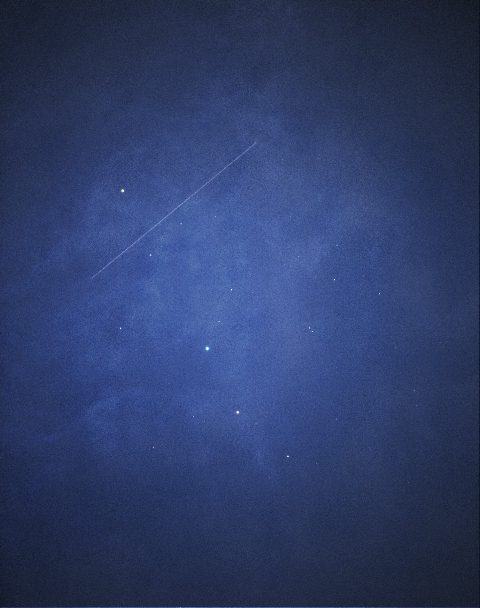
Trevor Paglen,
LACROSSE ONYX II, from The Other Night Sky [via]
Ironically, it’s exactly these sky surveys–or more precisely, their contamination–that is the subject of geographer/artist Trevor Paglen’s next exhibition, which opens at the Berkeley Art Museum/Pacific Film Archive on June 1st. Similar to his extra-long-distance photographs of clandestine government “black sites” and his tracking and documentation of planes used by the CIA for extra-legal renditions, Paglen uses data from amateur satellite-spotting enthusiasts to photograph top secret surveillance satellites in orbit:
Paglen photographs barely perceptible traces of these vessels amidst familiar star fields, in this way borrowing a language of scientific visualization of the cosmos. The multimedia installation at the center of the exhibition The Other Night Sky gestures toward the popular presentation of scientific knowledge in space centers and natural history museums by offering a large-scale globe animated with 189 currently orbiting satellites. Their orbits are traced via complex algorithmic analysis of data. The density of satellites is surprising, their coverage of the globe nearly complete. But the evidentiary function of the work is thwarted—although photographs are named for depicted satellites, faint streaks verify their existence, and the projections track their real-time movements, there is no information to glean from the images about the satellites themselves or their particular roles. And so again Paglen points us to the physical manifestations of the black world, while the images themselves embody the impossibility of translating such an act of seeing into an act of understanding.
Press release: Trevor Paglen: The Other Night Sky (June 1 – September 14, 2008) at BAM/PFA [berkeley.edu thanks elizabeth]
Trevor Paglen’s site
Les Satelloons Du Grand Palais
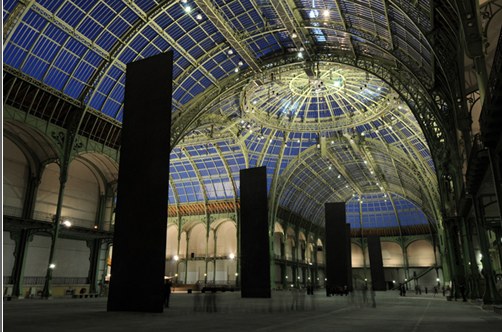
Promenade is Richard Serra’s commission for Monumenta, the contemporary arts program inaugurated last year in the nave of the newly restored Grand Palais in Paris.
Serra’s work consists of five 17×4-meter steel plates set vertically along the central axis of the Grand Palais. The size of the slabs was determined in part by technical limitations of the steel mill, and in part by the dimensions of the massive, open space itself: 35m high, rising to 60m at the cupola, 50m wide, and 200m long.
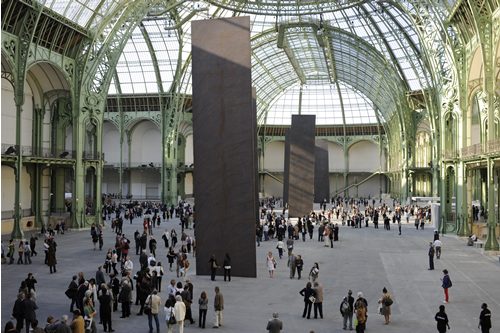
So Serra Schmerra, that means the Grand Palais is big enough to exhibit my re-creation of NASA’s satelloon. At least the Project Echo I, which was 100 feet in diameter. [Echo II was 135 feet, which might be a tight squeeze.] Unlike with the other two indoor venues capable of housing the work, the Pantheon in Rome and Grand Central Station in Manhattan, Monumenta gives the Grand Palais the advantage of a pre-existing, curated contemporary art context.
In recent high-profile museum building projects from the Guggenheim Bilbao to MoMA, Richard Serra’s multi-ton sculptures have been the default unit of measure; floors must be able to bear and spaces must be able to accommodate a Serra. The continued utility of such Serra Unit-based architecture. Just as screen-based art tests the programmability of art spaces, presenting a gigantic yet inconsequentially light object like a Satelloon as an art object poses an exhibition challenge of a different scale.
Here is a rough artist’s conception:
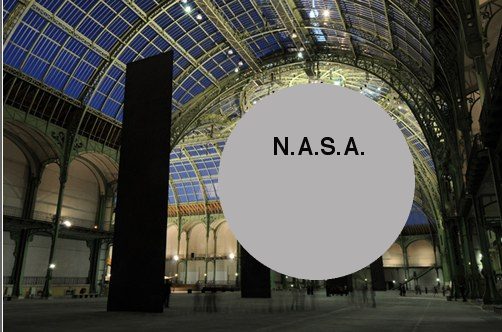
Now all I need to do to exhibit the Satelloon in Paris is to develop a body of work and a career comparable to Serra’s and last year’s Monumenta artist, Anselm Kiefer. So yeah, let me get right on that.
Hal Foster on Serra at the Grand Palais [lrb]
Monumenta 2008, including photos from the opening by Lorenz Kienzle [monumenta.com]
Matthew Barney: Big Bucks, Many Whammies
Christopher Knight didn’t have as bad a time at the performance/filming of Matthew Barney’s “REN” as the audience members who were injured by flying glass when the backhoe went at it with the Chrysler Imperial in the auto dealer showroom:
When paramedics left, the crowd filed into the tomb — actually the car-lined former service bay. Lila Downs, the great Oaxacan ranchera singer, wailed at a corpse laid out atop a golden Grand Am. A “menstrual shroud” was extracted from the loins of a masked nude woman. Somebody said that locusts were released in the parking lot, but I didn’t see them.
Then we all drove home.
It had been a long evening of checking off source materials: Richard Prince, Paul McCarthy, Charles Ray, Kiki Smith, “Cleopatra,” Al Gore, etc. The industrial coupling was pure Survival Research Labs, the Northern California heavy-industrial performance troupe that has been artistically disemboweling the military-industrial complex for 30 years.
Still, most interesting was the crypto-performance going on around the crypto-Egypto main event. Plenty of official cameras promised future “REN” shows, while performance shards were carefully collected.
I used to think that the most interesting thing about Barney’s work was how he made it, or got it made. I’m not surprised that Barney’s pressing his luck in the home the Live Studio Audience.
Matthew Barney’s ‘REN’ [lat via man]
Oh Wow. Captain & Tenille & Lawrence & Welk
Unless they were on a group tour to Italy or something, my grandparents watched the Lawrence Welk show every Saturday night. When I was trying to score the second installment of The Souvenir Series, the one based on my grandfather’s old dry cleaners, I really wanted to find a way to use Lawrence Welk music, and a young composer and I wracked our brains for a way in. But it was just unassailable, impervious to any kind of deconstruction or irony.
But maybe it was just too much and too soon. Watching Bobby Burgess and Cissy King dance to a 1977 big band arrangement of the Captain & Tenille classic, “Love Will Keep Us Together,” I realize that Lawrence Welk is what it is, a wholly realized artform all its own. Somehow only 353 other people have realized it, too. [via archival clothing]
Turns out yesterday was Mr. Burgess’s birthday!
Introducing The Suck Cola Registry
In 1996, I went to some weird little Internet expo at the New York Coliseum. The folks from Suck.com were there, and I got this bottle of Suck Classic Cola. It was my first piece of WWW swag [no one really said “dotcom” yet in 1996 who didn’t work for Time Magazine.]
I know of one other bottle. At least until he quit, it was on the bookshelf in a friend’s office at Time Warner [which, ironically, was built on the site of the NY Coliseum]. Except for three <3-hour periods when I moved, and this morning when it dropped on my foot, mine has been in my refrigerator since 1996.
1996 was the year Suck memorialized Coca Cola’s beautiful utter failure of Gen X marketing, OK Soda by calling for OK fans to send them cans, promotional materials, even vending machines.
It is in that spirit, but without a bunch of old Coke bottles coming to me, that I hereby inaugurate The Suck Cola Registry, a virtual gathering of all the world’s remaining bottles of Suck Cola.
If you have a bottle or know of a bottle of Suck Cola, please add it to the Registry. by providing the following data:
Cola Owner
Cola Photo [jpg or URL]
Cola Location [i.e., city/state/country, not “in a box in my storage unit”]
After your Cola information is reviewed and validated, you will be issued a Suck Cola Registry Number. I have designated my bottle SC0005, having reserved the first four Registry Numbers, SC0001-SC0004, for Suck.com co-founders Joey Anuff and Carl Steadman. Thank you.
Related: 10 OK Soda cans [empty] in various designs and excellent condition, currently $1 on eBay


